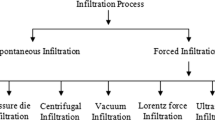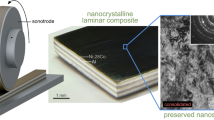Abstract
We show that steel-magnesium alloy laminated metal composites (LMCs) can be produced by gas pressure infiltration of a liquid magnesium alloy between layers of stacked dimpled steel sheets. Resulting LMCs are amenable to subsequent warm rolling. The LMCs are free of pores or brittle intermetallics and feature, in the as-cast condition, metal layers of uniform thickness and spacing. The ultimate tensile strength of the as-cast LMCs, of 260 MPa, obeys the “rule-of-mixtures” (ROM). The uniform tensile elongation, of around 20 pct, makes the infiltrated LMC nearly as ductile as the bulk steel it contains, implying that the magnesium alloy in the as-cast LMCs has a substantially increased tensile ductility in comparison to its metallurgically equivalent bulk state. Rolling reduces the metal layer thicknesses, causes waviness in the interface, and makes the LMCs stronger but less ductile, by factors in the vicinity of 2 for both properties; the main cause for this is work hardening in the steel layers.












Similar content being viewed by others
References
C.S. Smith: A History of Metallography, 1988 paperback ed., MIT Press, Chicago, IL, 1960, pp. 3–65.
J. Wadsworth and D.R. Lesuer: Mater. Charact., 2000, vol. 45, pp. 289–313.
D.R. Lesuer, C.K. Syn, O.D. Sherby, J. Wadsworth, J.J. Lewandowski, and W.H. Hunt, Jr.: Int. Mater. Rev., 1996, vol. 41, pp. 169–97.
D. Embury and O. Bouaziz: Annu. Rev. Mater. Res., 2010, vol. 40, pp. 213–41.
S.T. Mileiko: J. Mater. Sci., 1969, vol. 4, pp. 974–77.
S.L. Semiatin and H.R. Piehler: Metall. Trans. A, 1979, vol. 10A, pp. 85–96.
G. Garmong and R.B. Thompson: Metall. Trans., 1973, vol. 4, pp. 863–73.
S. Nambu, M. Michiuchi, Y. Ishimoto, K. Asakura, J. Inoue, and T. Koseki: Scripta Mater., 2009, vol. 60, pp. 221–24.
C.K. Syn, D.R. Lesuer, J. Wolfenstine, and O.D. Sherby: Metall. Trans. A, 1993, vol. 24A, pp. 1647–53.
S. Nambu, M. Michiuchi, J. Inoue, and T. Koseki: Compos. Sci. Technol., 2009, vol. 69, pp. 1936–41.
J. Inoue, S. Nambu, Y. Ishimoto, and T. Koseki: Scripta Mater., 2008, vol. 59, pp. 1055–58.
H. Westengen and T.K. Aune: in Magnesium Technology: Metallurgy, Design Data, Applications, H.E. Friedrich and B.L. Mordike, eds., Springer-Verlag, Berlin-Heidelberg, 2006, pp. 145–204.
B.L. Mordike and T. Evert: Mater. Sci. Eng. A, 2001, vol. A302, pp. 37–45.
J.C. Viala, D. Pierre, F. Bosselet, M. Peronnet, and J. Bouix: Scripta Mater., 1999, vol. 40, pp. 1185–90.
M. Sacerdote-Peronnet, E. Guiot, F. Bosselet, O. Dezellus, D. Rouby, and J.C. Viala: Mater. Sci. Eng. A, 2007, vols. 445–446, pp. 296–301.
F. Yoshida and R. Hino: J. Mater. Process. Technol., 1997, vol. 63, pp. 66–71.
C.S. Roberts: Magnesium and Its Alloys, John Wiley & Sons, New York, NY, 1960, pp. 57 and 159.
E.F. Emley: Principles of Magnesium Technology, 1st ed., Pergamon Press, Oxford, United Kingdom, 1966, p. 941.
M.A. Thein, L. Lu, and M.O. Lai: Mater. Sci. Eng. A, 2010, vol. A528, pp. 239–46.
W.J. Kim, H.W. Lee, S.J. Yoo, and Y.B. Park: Mater. Sci. Eng. A, 2010, vol. 528, pp. 874–79.
M. Selin: Metall. Mater. Trans. A, 2010, vol. 41A, pp. 2805–15.
K. Nestler, J. Bohlen, D. Letzig, and K.U. Kainer: in Magnesium Technology, R.S. Beals, A.A. Luo, N.R. Neelameggham, and M. Pekguleryuz, eds., TMS, Warrendale, PA, 2007, pp. 95–100, CD-ROM.
B. Closset: in Magnesium Technology: Metallurgy, Design Data, Applications, H.E. Friedrich and B.L. Mordike, eds., Springer-Verlag, Berlin-Heidelberg, 2006, pp. 289–315.
H. Somekawa, Y. Osawa, and T. Mukai: Scripta Mater., 2006, vol. 55, pp. 593–96.
H. Somekawa and T. Mukai: J. Alloys Compd., 2006, vol. 417, pp. 209–13.
Z. Suo: Appl. Mech. Rev., 1990, vol. 43, pp. S276–S279.
H.C. Cao and A.G. Evans: Acta Metall. Mater., 1991, vol. 39, pp. 2997–3005.
J.W. Hutchinson and Z. Suo: in Advances in Applied Mechanics, J.W. Hutchinson and T.Y. Wu, eds., Academic Press Inc., San Diego, CA, 1992, pp. 63–191.
R.J. Roark and W.C. Young: Formulas for Stress and Strain, 5th ed., McGraw-Hill Book Co., New York, NY, 1975, p. 100.
Metals Handbook, vol. 1, Elevated-Temperature Properties of Ferritic Steels, ASM INTERNATIONAL, Materials Park, OH, 1990, p. 682.
Specification for Structural Steel Buildings, American Institute of Steel Construction (AISC), ANSI/AISC 360-05, Chicago, IL, 2005, p. 182.
Acknowledgments
This work was sponsored by the Collaborative Research Program between the University of Tokyo and the Ecole Polytechnique Fédérale de Lausanne supported by the Toyota Motor Corporation. The authors are very grateful to the team of the Materials (ATMX) workshop at EPFL, notably to Mr. Werner Brönnimann, for their fine work and helpful advice.
Author information
Authors and Affiliations
Corresponding author
Additional information
Manuscript submitted December 17, 2010.
Appendices
Appendix A
1.1 Dimpling the steel
The steel sheets were dimpled using a small device including a punch and two aluminum plates (one upper and one lower, Figure A1). The upper plate contains cylindrical holes 1.02 mm in diameter, while the lower plate has matching conical indentations, 1 mm in diameter at the top and 0.5-mm deep. A drawing of the aluminum upper plate is given in Figure A2. Arrangements of dimples in dimpled and nondimpled specimens are given in Figures A3 and A4, for as-cast and rolled samples, respectively.
Arrangement of dimples used in the production of tensile specimens of rolled specimens: with (a) 0.1-mm thickness in the nondimpled configuration, (b) 0.1-mm thickness in the dimpled configuration, (c) 0.2-mm thickness in the nondimpled configuration, and (d) 0.2-mm thickness in the dimpled configuration. All dimensions are in millimeters. The tensile specimens were machined after infiltration, solidification, and rolling
Appendix B
2.1 Assessment of steel sheet stability during infiltration
The resistance to flow of a channel varies as the square of its width: if only for this reason, the molten magnesium alloy is likely to infiltrate the various channels defined between individual steel sheets at different moments. As a result, one side of a steel sheet may be in contact with pressurized molten magnesium alloy while the other side is still under vacuum. This, in turn, will drive the steel sheet to bend.
In order to assess whether this situation will cause the steel sheets to undergo plastic deformation, bending stresses were computed based on elementary linear theory (considering small deflections and linear elasticity). A simple yet realistic one-dimensional geometrical model for the bending of the steel sheets in the present situation is a rectangular cross-sectional beam under a uniform load W with both ends clamped (Figure B1).
The moment of inertia I of a rectangular cross-sectional beam of width b and thickness t is given by[29]
The maximum deflection of a beam of length l under a uniform load W (i.e., under uniform applied pressure) with both ends clamped is[29]
where E is the Young’s modulus of the beam.
The maximum stress in the beam is[29]
where the maximum moment M max is given as[29]
The temperature during infiltration was 983 K (710 °C). As a result, both the Young’s modulus and the proof stress of steel sheets are reduced compared to room temperature; these are estimated as 140 GPa[30] and 60 MPa,[31] respectively.
The maximum and minimum pressures applied during infiltration were 0.2 and 0.03 MPa, respectively. Table B1 summarizes maximum deflections and bending stresses for these two values, for sheets either 0.2- or 0.1-mm thick, with a free length between spacers equal to 30 mm, corresponding to the gage length of tensile samples. As seen, in either case, bending stresses far exceed the elastic limit of the steel. Predicted deflections generally exceed those admitted by linear theory and also exceed the distance between sheets. Therefore, it is likely that uncontrolled deflection of the steel sheets will occur during infiltration if no additional spacers are used. Preliminary experiments confirmed this; without dimples, composites contain stacked touching layers of steel pushed apart by molten magnesium.
Spacers are thus required in order to prevent uncontrolled bending. Table B2 examines the placement of additional spacers, created for example by dimpling the steel sheets. Here, a maximum allowable bending stress is set, at the elastic limit of the steel (60 MPa), and the maximum free distance between the dimples is computed. Computed deflection values remain well below the distance between the steel sheets. Depending on sheet thickness and loading conditions, distances between dimples have to be below 11 mm down to 2 mm if plastic deformation of the sheets is to be avoided. Dimple spacings used in the present experimental work are near 10 mm: the present computations suggest that the steel sheets bend at the onset of pressurization (i.e. at 0.03 MPa), this spacer separation distance being just short enough to avoid bending of 0.2 mm sheets, but not of the 0.1 mm sheets. Experiments show no sign of extensive bending with both steel thicknesses, Figure 1; assumptions used in the calculations are thus apparently conservative.
Rights and permissions
About this article
Cite this article
Çetin, A., Krebs, J., Durussel, A. et al. Laminated Metal Composites by Infiltration. Metall Mater Trans A 42, 3509–3520 (2011). https://doi.org/10.1007/s11661-011-0756-2
Published:
Issue Date:
DOI: https://doi.org/10.1007/s11661-011-0756-2









